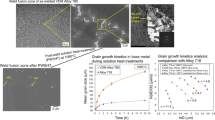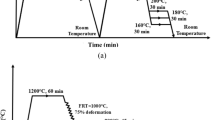Abstract
In this study, Cu-alloyed ductile cast iron treated by different first-step temperatures and times was investigated. The influence of the amount, morphology and distribution of acicular ferrite and retained austenite on the mechanical properties of the two-step austempered ductile iron (ADI) was analyzed. The results indicated that acicular ferrite was both nucleated and grown in two-step austempering. The thinner and sharper acicular ferrite formed at lower temperature at first step austempering was the ferrite needle, the thicker and blunt acicular ferrite formed at higher temperature at second step austempering was ferrite bunch. Ausferrite refinement, austenitic volume fraction and stability were strongly influenced by the phase transformation amount during first step austempering. A low transformation amount at the first- step of austempering process led to a decrease in austenite stability, which resulted in martensite formation and was detrimental to the mechanical properties. The overmuch transformation amount at the first-step of austempering process led to a similar morphologic ausferrite compared to single step ADI treated at the corresponding first-step temperature, which showed minimal improvement in the comprehensive mechanical properties. The maximum ultimate tensile strength, yield strength and elongation reached 1280, 1190 MPa, 10.2% respectively, as the first-step temperature increased to 280 °C due to the ausferrite refinement. The impact energy and fracture toughness maintained an increasing trend and reached a maximum at 93.5 J and 66.72 MPa m1/2, respectively, as the first-step temperature increased to 320 °C. The ultimate tensile strength and yield strength gradually increased with the first-step time increased, while the elongation, impact energy and fracture toughness gradually decreased. Ausferrite refinement was attributed to the appropriate amount of ferrite needles transformed at first step austempering, which was mainly reason for strength improvement. Austenitic volume fraction and stability increasing were the main influence factor for ductility and toughness of two-step Cu-alloyed ADI. The transformation-induced-plasticity (TRIP) effect was only effective as the induced transformation behavior was retarded to yield, which was also depended on austenitic stability. An optimal combination of ausferrite refinement, austenitic volume fraction and austenitic stability could be achieved through the appropriate first step transformation amount, which together influence the mechanical properties of Cu-alloyed ADI.

















Similar content being viewed by others
References
P.P. Rao, S.K. Putatunda, Influence of microstructure on fracture toughness of austempered ductile iron. Metall. Mater. Trans. A 28, 1457–1470 (1997)
J. Lefevre, K.L. Hayrynen, Austempered materials for powertrain applications. J. Mater. Eng. Perform. 22, 1914–1922 (2013). https://doi.org/10.1007/s11665-013-0557-4
F.H. Çakir, The effect of cryogenic treatment on hardness, toughness, and tribological properties of austempered ductile iron with different nickel contents. Int. J. Metalcast.Metalcast. 16, 1442–1454 (2021). https://doi.org/10.1007/s40962-021-00686-5
N. Zhang, J. Zhang, L. Lu, M. Zhang, D. Zeng, Q. Song, Wear and friction behavior of austempered ductile iron as railway wheel material. Mater. Des. 89, 815–822 (2016). https://doi.org/10.1016/j.matdes.2015.10.037
J. Shah, Light-weighting technologies for high-performance ductile iron sand castings. Int. J. Metalcast.Metalcast. 14, 656–662 (2020). https://doi.org/10.1007/s40962-020-00423-4
F. Zanardi, F. Bonollo, G. Angella, N. Bonora, A contribution to new material standards for ductile irons and austempered ductile iron. Int. J. Metalcast.Metalcast. 11, 136–147 (2017). https://doi.org/10.1007/s40962-016-0095-6
S.-F. Liu, Y. Chen, X. Chen, H.-M. Miao, Microstructures and mechanical properties of helical bevel gears made by Mn-Cu alloyed austempered ductile iron. J. Iron. Steel Res. Int. 19, 36–42 (2012). https://doi.org/10.1016/s1006-706x(12)60057-0
F. Zanardi, C. Mapelli, S. Barella, Reclassification of spheroidal graphite ductile cast irons grades according to design needs. Int. J. Metalcast.Metalcast. 14, 622–655 (2020). https://doi.org/10.1007/s40962-020-00454-x
W.L. Guesser, C.L. Lopes, P.A.N. Bernardini, Austempered ductile iron with dual microstructures: effect of initial microstructure on the Austenitizing process. Int. J. Metalcast.Metalcast. 14, 717–727 (2020). https://doi.org/10.1007/s40962-019-00397-y
A. Meena, M. El Mansori, Material characterization of austempered ductile iron (ADI) produced by a sustainable continuous casting-heat treatment process. Metall. and Mater. Trans. A. 43, 4755–4766 (2012). https://doi.org/10.1007/s11661-012-1271-9
J. Zhang, N. Zhang, M. Zhang, L. Lu, D. Zeng, Q. Song, Microstructure and mechanical properties of austempered ductile iron with different strength grades. Mater. Lett. 119, 47–50 (2014). https://doi.org/10.1016/j.matlet.2013.12.086
S.K. Putatunda, Development of austempered ductile cast iron (ADI) with simultaneous high yield strength and fracture toughness by a novel two-step austempering process. Mater. Sci. Eng. A 315, 70–80 (2001)
J. Yang, S.K. Putatunda, Improvement in strength and toughness of austempered ductile cast iron by a novel two-step austempering process. Mater. Des. 25, 219–230 (2004). https://doi.org/10.1016/j.matdes.2003.09.021
K.S. Ravishankar, P.P. Rao, K.R. Udupa, Improvement in fracture toughness of austempered ductile iron by two-step austempering process. Int. J. Cast Met. Res. 23, 330–343 (2013). https://doi.org/10.1179/136404610x12693537270091
A. Hegde, S. Sharma, R. Hande, G. B M and I. P. Jones, Microstructure and mechanical properties of manganese-alloyed austempered ductile iron produced by novel modified austempering process. Cogent Engineering. 9, (2022). https://doi.org/10.1080/23311916.2022.2046301
P.-Y. Yi, E.-J. Guo, L.-P. Wang, Y.-C. Feng, C.-L. Wang, Effect of Cu content on microstructures and mechanical properties of ADI treated by two-step austempering process. China Foundry. 16, 168–176 (2019). https://doi.org/10.1007/s41230-019-8145-3
P.-Y. Yi, E.-J. Guo, L.-P. Wang, Y.-C. Feng, C.-L. Wang, Microstructure and mechanical properties of twostep Cu-alloyed ADI treated by different second step austempering temperatures and times. China Foundry. 16, 342–351 (2019). https://doi.org/10.1007/s41230-019-9064-z
J.M. Han, Q. Zou, G.C. Barber, T. Nasir, D.O. Northwood, X.C. Sun, P. Seaton, Study of the effects of austempering temperature and time on scuffing behavior of austempered Ni–Mo–Cu ductile iron. Wear 290–291, 99–105 (2012). https://doi.org/10.1016/j.wear.2012.05.003
O. Erić, D. Rajnović, S. Zec, L. Sidjanin, M.T. Jovanović, Microstructure and fracture of alloyed austempered ductile iron. Mater CharactCharact. 57, 211–217 (2006). https://doi.org/10.1016/j.matchar.2006.01.014
L. Yan, Study on the phase transformation of QTD1050-6 Austempered ductile Iron (Harbin University of Science and Technology, Harbin, 2017). ((In Chinese))
ASTM 975-13, Standard Practice for X-Ray Determination of Retained Austenite in Steel with Near Random Crystallographic Orientation (A. International, USA, 2003)
ASTM E8/E8M-22, Standard Test Methods for Tension Testing of Metallic Materials (A. International, USA, 2022)
ASTM E23-18, Standard Test Methods for Notched Bar Impact Testing of Metallic Materials (A. International, USA, 2018)
ASTM A897/A897M-16, Standard Specification for Austempered Ductile Iron Casting (A. International, USA, 2016)
ASTM E1820-18, Standard Test Method for Measurement of Fracture Toughness (A. International, USA, 2018)
ASTM E10-18, Standard Test Method for Brinell Hardness of Metallic Materials (A. International, USA, 2018)
B.V. Kovacs, On the terminology and structure of ADI. AFS Trans. 102, 417–420 (1994)
C.-H. Hsu, T.-L. Chuang, Influence of Stepped Austempering Process on the Fracture Toughness of Austempered Ductile Iron. Metall. Mater. Trans. A 32, 2509–2514 (2001). https://doi.org/10.1007/s11661-001-0040-y
D. De Knijf, R. Petrov, C. Föjer, L.A.I. Kestens, Effect of fresh martensite on the stability of retained austenite in quenching and partitioning steel. Mater. Sci. Eng. A 615, 107–115 (2014). https://doi.org/10.1016/j.msea.2014.07.054
J. Yang, S.K. Putatunda, Effect of microstructure on abrasion wear behavior of austempered ductile cast iron (ADI) processed by a novel two-step austempering process. Mater. Sci. Eng. A 406, 217–228 (2005). https://doi.org/10.1016/j.msea.2005.06.036
T. Takahashi, T. Abe, S. Tada, Effect of bainite transformation and retained austenite on mechanical properties of austempered spheroidal graphite cast steel. Metall. Mater. Trans. A 27, 1589–1598 (1996)
X.C. Xiong, B. Chen, M.X. Huang, J.F. Wang, L. Wang, The effect of morphology on the stability of retained austenite in a quenched and partitioned steel. Scripta Mater. Mater. 68, 321–324 (2013). https://doi.org/10.1016/j.scriptamat.2012.11.003
I. Tamura, Deformation-induced martensitic transformation and transformation-induced plasticity in steels. Metal Sci. 16, 245–252 (1982)
S. Panneerselvam, C.J. Martis, S.K. Putatunda, J.M. Boileau, An investigation on the stability of austenite in Austempered Ductile Cast Iron (ADI). Mater. Sci. Eng. A 626, 237–246 (2015). https://doi.org/10.1016/j.msea.2014.12.038
S. Daber, K.S. Ravishankar, P. Prasad Rao, Influence of austenitising temperature on the formation of strain induced martensite in austempered ductile iron. J. Mater. Sci. 43, 4929–4937 (2008). https://doi.org/10.1007/s10853-008-2717-8
G. Lacroix, T. Pardoen, P.J. Jacques, The fracture toughness of TRIP-assisted multiphase steels. Acta Mater. Mater. 56, 3900–3913 (2008). https://doi.org/10.1016/j.actamat.2008.04.035
Funding
This work was financially supported by the National Natural Science Foundation of China. (Grant Nos. 51374086 and 51674094).
Author information
Authors and Affiliations
Corresponding author
Additional information
Publisher's Note
Springer Nature remains neutral with regard to jurisdictional claims in published maps and institutional affiliations.
Rights and permissions
Springer Nature or its licensor (e.g. a society or other partner) holds exclusive rights to this article under a publishing agreement with the author(s) or other rightsholder(s); author self-archiving of the accepted manuscript version of this article is solely governed by the terms of such publishing agreement and applicable law.
About this article
Cite this article
Pengyue, Y., Erjun, G., Liping, W. et al. Effect of First-Step Temperature and Time on the Microstructure and Mechanical Properties of the Two-Step Cu-Alloyed ADI. Inter Metalcast (2023). https://doi.org/10.1007/s40962-023-01211-6
Received:
Accepted:
Published:
DOI: https://doi.org/10.1007/s40962-023-01211-6




